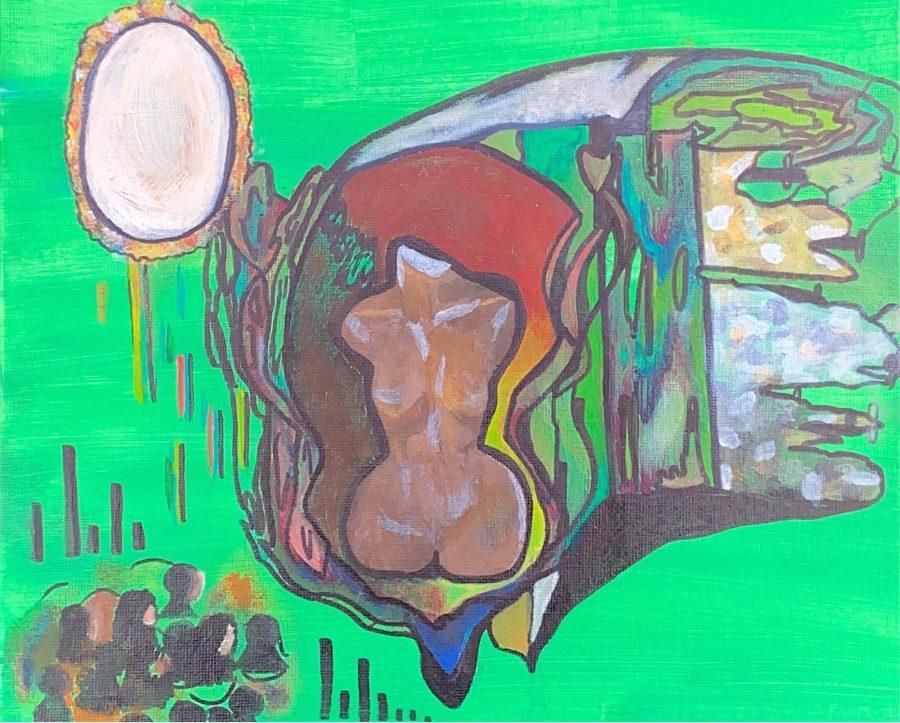With the rise of prominent black, female Hip-Hop artists like Cardi B and Megan Thee Stallion, a market for more female artists was created as it has become more popular. This new market has blurred the line between expression and marketing.
Hip hop arose to reflect not just the artists’ individual selves, but also situations personal to their upbringing such as economic hardships and personal environment. Though hip hop first emerged as a male-dominated arena, the genre has evolved to incorporate more individuals and themes that extend beyond upbringing. Black female hip-hop artists have come to claim the stage with their own flair, oftentimes focusing on what it means to own the role as a woman as well as a Black woman.
With the optimism though, there are also clashing viewpoints on the plethora of uninhibited, sexual content that comes along as well — something that invokes different groups’ ideologies.
Near the start of February, artist Cardi B released the music video for her new song “Up.” There is a stark, almost comedic contrast between the music video and the beloved Pixar movie of the same name. As for both, they’ve struck audience members as iconic pieces of media — albeit in different ways.
In the song, which has already amassed more than 72 million views since its release on YouTube and been a part of the Billboard charts for three weeks, Cardi B doesn’t stray from what she’s embraced in many of her hit songs, one of the most recent being “WAP”: themes of body liberation and unrelentingly vibrant, sexual language.
Cardi B’s song “Up” isn’t a one-hit wonder, either. From 2017 to 2020, Cardi B proved that her rise in prominence wasn’t due to a stroke of luck. For those four years, she was an artist of the Top 5 R&B/Hip-Hop Artists Females year-end Billboard charts.
In the same vein, according to a 2017 year-end report from Nielsen Music, the hip-hop genre has only been steadily increasing in popularity, with 17 of the 19 songs that surpassed 500 million streams in that year coming from the R&B/hip-hop genre.
Part of the success of these artists today comes from examining the Black female hip hop artists that propelled themselves forward as well as other incoming Black artists. They addressed transgressions against them, with much of it connecting to their experiences growing up.
Queen Latifah and MC Lyte were among the first female artists to emerge onto the hip hop field. They wore baggy, sometimes “boyish” attire like their male counterparts of this time. But the messages they preached weren’t necessarily the same as the men’s. They often detailed their experiences as Black women and as women, after all. Queen Latifah, for instance, wrote a song called “U.N.I.T.Y.”, and it won the Grammy for best solo rap performance in 1994. In the song, she examined the degrading words used against women by men to stifle and denigrate them. MC Lyte explored her own desires in her song “Ruffneck” and didn’t shy away from sexually freeing lyrics.
Cardi B’s lyricism—as exemplified in her hit song “Up”—established a sense of assertiveness and liberation of one’s body that is also evident in other songs from fellow Black hip hop female artists such as Megan Thee Stallion, Doja Cat, Flo Milli, Rubi Rose, and CupcakKe today. In the music video, Cardi B’s skin-tight, confident attire is as unwaveringly free as the lyrics themselves.
The body-positive themes touched on by Cardi B align with a more liberal feminism or mainstream feminism. According to the Stanford Encyclopedia of Philosophy, the objective lies in giving women personal and political autonomy. This translates to letting the individual do what she pleases with her body.
To start, it is crucial to note that there are differing waves of feminism. These include but are not limited to first-wave feminism, second-wave feminism, and third-wave feminism or today’s kind of feminism. The first fixated on suffrage and the basic rights for women.
As with second-wave feminism, much of the population of interest was white women, though the focus was on equality here. Today’s feminism, or third-wave feminism, is more embracing of sex positivity as well as intersectionality and a rejection of gender binaries. Some choose to call this “raunch culture.” Feminist writer Ariel Levy substantiates this further by saying that such a culture isn’t progressive when women are capable of acting as participants of their own objectification.
While some see the more explicit music as liberating, others see the same content as objectifying or repressive.
When considering how commercialism can modify artists’ works to become palatable to the mainstream in homogenous ways, the works may include damaging themes like misogyny — something an artist may not even be aware of. Notably, a corporation may wish to develop a distinct image, and if it’s the sexualized image of a woman that sells, those actions to push such content will persist.
This homogeneity of sexualized content may not be a reflection of what the artist themself desires to put out or believes in. It is oftentimes a reflection of what audiences wish to see and what the music industries end up delivering.
With the Telecommunications Act of 1996 came deregulation of media ownership,which came with less room to be popular due to the control of radio’s airwaves.
Cardi B and Megan Thee Stallion’s “WAP” claimed the No. 1 spot for four weeks on Billboard charts. Nicki Minaj’s “Anaconda” spent 26 weeks on the Billboard chart. If this is the image that appeals to mass audiences, this is what will continue being produced.
Communications studies professor, Jared Ball, of Morgan State University states that the consolidation of commercial media ownership limits what Black cultural production becomes popular or not. The desire for profit for major record labels may come at the expense of sincerely pushing forward an artist’s own values.
On the same note, explicit such as these may invoke the sexualization of African American women, which involves deeper roots. A journal from Psychology of Women Quarterly emphasizes that the history of perceptions of Black women goes deep. Black women were objectified, sometimes put in cages to be seen for their external attributes by white Europeans in the 18th century.
In a more recent light, according to a qualitative study on the effects of images of African American women in hip hop on youths’ attitudes toward physical attractiveness and interpersonal relationships, the authors describe eight images accepted in hip hop as the Diva, the Gold Digger, the Freak, the Dyke, Gangster, Sister Savior, Earth Mother, and Baby Mama. The perceptions of the eight images from the interviewees differed, but the implications were clear. These images had effects on the individuals’ self-perceptions as well as their interpersonal relationships.
As per their findings, there is the idea that current cultural frameworks of their sexuality do not display women as empowered outside of men’s eyes. The youth, then, may grow up being at risk of internalized misogyny. With aspects external to them like the male gaze, this can further objectification of women even if the objective is to reclaim one’s sexuality.
When women starred in men’s videos, their purpose was oftentimes in what they represented to accentuate a man’s — the male rapper’s — status. Today’s contemporary hip hop from women paves a space for these women, instead, to become the representative, as they have been increasingly able to compete and succeed with the men in the same genre. Regardless of artistic intent and the artist’s desire to claim agency of their own bodies, these still may not exempt them from objectification.
Cheryl Wang, a contributor for HuffPost, poses a question in her article on celebrity raunch culture of whether the flaunting and overexposure of the body in sexualized ways can indicate the presence of feminism or endorses the notion that women’s self worth only comes from appealing to men. In other words, her article evokes the notion of how “sex sells.”
Still, if the objective of some music such as these is said to be empowering, perhaps some might argue that it needs to be mutually exclusive to the immense fame — relative to other songs — one derives from their releases. Otherwise, intentions get foggy.
In Flo Milli’s music video “Weak,” she allows men in similar clothes to follow her and do “maternal” chores for her such as ironing money while she contrasts her lifestyle with other women’s. In “Juicy,” by Doja Cat, she dresses in vibrant fruits and celebrates her natural beauty. Both songs embrace body liberation, but engaging in behavior that degrades other women’s or potential self-objectification also calls to question how the mass audience will be receptive in genuinely positive, body-loving ways.
Black female hip hop artists have been tackling this concept and confronting stereotypes and statements by others on who they should be on their own terms. Cardi B and Megan Thee Stallion are just a few Black artists who display themselves as individuals capable of the more sexual — something that was not always accepted or even tolerated. And they take it, unapologetically, by the reigns regardless of whether it lands well for everyone.
Due to the diverse viewpoints of individuals, there seems to be little unanimity as to whether the more explicit music videos these artists release are capable of representing the individual in ways that are empowering. But the question is whether it even matters.
The objective of many music platforms like Spotify or YouTube is not always to focus on something deep and substantial. Oftentimes, the purpose is to just entertain and reach as many people as possible. Still, perhaps if the intention is to make empowering content, lines can blur when it comes to lucrative “kinds” of songs.
But perhaps, that isn’t in the hands of Black hip hop artists most of the time anyway. One thing is clear, though. The music video “Up”— like the movie of the same name — has been going up and remains popular with audiences.
Art courtesy of Thushani Gunaratne, a second year student from UC Davis, for the UCSD Guardian.
















AndyShugh • Apr 2, 2021 at 9:57 pm
Drink This Before Breakfast Burns 1lb A Day?
https://bit.ly/30B2dYg
ToniShugh • Mar 31, 2021 at 5:11 pm
Your FREE Angel Bracelet Will Be Shipped From Denver, USA
https://shorturl.at/dfBUW
CristineShugh • Mar 28, 2021 at 10:08 am
The Natives Have Used Ingredients From This Natural Pink Tonic To Target The Root Cause Of Belly Fat…
https://bit.ly/3qvRyc4
CandyShugh • Mar 28, 2021 at 1:12 am
3000-Year-Old Tonic Drink Melts 33lbs In 28 Days
https://bit.ly/2OMsmkA
StaceyShugh • Mar 27, 2021 at 5:26 pm
Japanese Red Soda Melts 3 Lbs Every 5 Days
https://bit.ly/3tbrfd8
Monte • Mar 13, 2021 at 11:39 pm
Drink This Japanese Tonic In The Morning To Burn 3 Lbs Every 3.5 Days
https://bit.ly/3tbrfd8
Kendall • Mar 11, 2021 at 4:37 am
Drink This Japanese Fat-Loss Tonic Before 10am To Lose Up To 7.7 In 7 Days
https://bit.ly/3tbrfd8